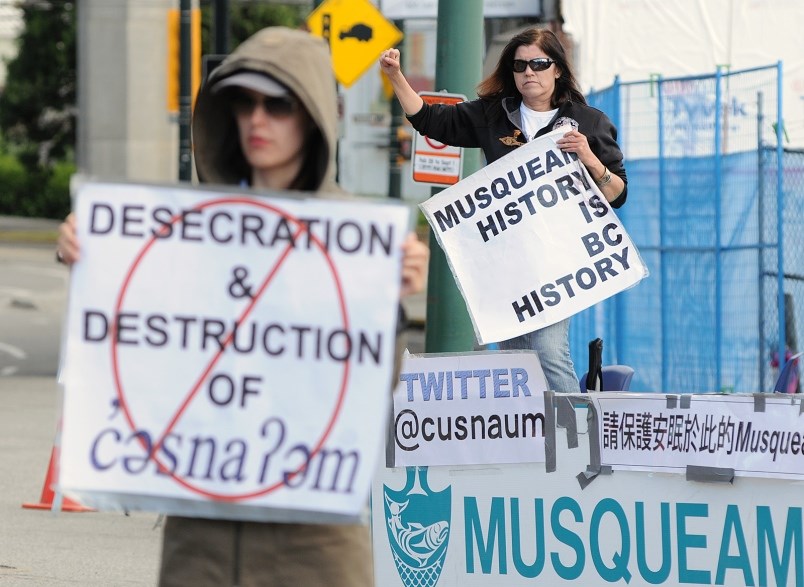The things you learn when you read deep into a lengthy city staff report about the city’s reconciliation efforts with First Nations: Did you know there are 730 so-called “sensitive sites” on public and private property in Vancouver?
Yes, 730.
Where are they located?
Why are they sensitive?
How many are on private property?
Questions I will try to answer in a few paragraphs.
First, here’s the part of that went to council this week and prompted me to ask further questions:
“In late 2017, the Development, Buildings and Licensing department inserted archeological warning flags in the city’s permitting system [POSSE] for 730 sites.
Since then, approximately 100 staff who are involved in permitting have been trained on how to use the archeological layer in POSSE in order to identify sensitive sites and take appropriate action before issuing ground disturbing permits.”
Private property owners might want to paste the next two sentences to their fridge…
“In March 2018, a further enhancement was made to POSSE to alert staff for sensitive property parcels on private property. This alert triggers either a compulsory archeological review or a checklist at specific project milestones to ensure required actions are completed.”
I wanted to find out more, specifically where the sites are located and how many were on private property. So I sent some questions via email to the city’s communications department.
Their response, in part:
“The sites noted in the report and indicated as ‘warning flags’ are based on information from the as those which could be of potential archeological significance. The city receives this site information directly from the province.
Under the B.C. Heritage Conservation Act, any contractor that discovers something that could be of archeological significance on one of these sites must stop digging and report it immediately.”
The city didn’t provide me with the location of the sites, or say how many were on private property, or public property for that matter; you’ve got to think Stanley Park is one of the sites.
I was told to contact the Archaeology Branch to get more information. I did that via email to the director. That was five days ago, and as of writing this sentence, I had not heard back.
So I made a few phone calls and got hold of Vivian Thomas, a spokesperson for the Ministry of Forests, Lands, Natural Resource Operations and Rural Development Contracts.
Like the city, Thomas couldn’t reveal where the sites are and how many are on private property, which would include houses and businesses.
Why?
I’m paraphrasing, but she said disclosing that information to the general public might cause some treasure hunters to conduct their own archeological dig, or vandalize a site.
“Looting” is the term Thomas used.
Such information is only available on a “need to know basis” to local governments, private property owners, realtors and First Nations, said Thomas, whose definition of a sensitive site included an ancient midden or burial site.
Generally, she added, the majority of the sites are related to First Nations. That applies to an estimated 50,000 sites across the province.
Asked whether a prospective home buyer in ¬È∂π¥´√Ω”≥ª≠would know whether the property is considered a sensitive site, Thomas replied:
“If you have a good realtor, you should,” she said, but couldn’t answer whether all realtors seek out that information.
After I spoke to Thomas, I received an email from one of her colleagues at the ministry with more information that a private property owner might also want to paste to the fridge.
From public affairs officer Dawn Makarowski:
‚ÄúPreviously unrecorded archeological sites are also protected under the Heritage Conservation Act, so ¬È∂π¥´√Ω”≥ª≠residents should be aware that even though they may not have received notice of the presence of archeological sites, it may reflect the lack of studies in the area, rather than the lack of protected archeological resources.‚Äù
In pursuing this topic, I was reminded of the controversy that erupted in 2012 when archeologists discovered intact remains of two adults and two infants on private property in Marpole believed to be ancestors of the Musqueam Indian Band.
Century Group HQ Developments Ltd. and property owners Gary and Fran Hackett planned to build a 108-unit condominium complex on the acre-sized property near the former Fraser Arms hotel until the Musqueam and provincial government intervened.
The response from the provincial government at the time was that it recognizes and respects private property rights and also recognizes the need to protect First Nations heritage resources.
The Hacketts, who owned the property for more than 50 years, ended up in 2013 for an undisclosed sum--believed to be several million dollars--to the Musqueam, which continues to work on plans to preserve the property that was once home to one of the band's ancient villages.
In announcing the deal, Chief Wayne Sparrow issued a statement saying: "The successful resolution of the development plans for these lands demonstrates First Nations and private property owners can work together to understand each others' interests and conduct business in a respectful way."
The Hacketts described the deal as "fair."
@Howellings
Ã˝



